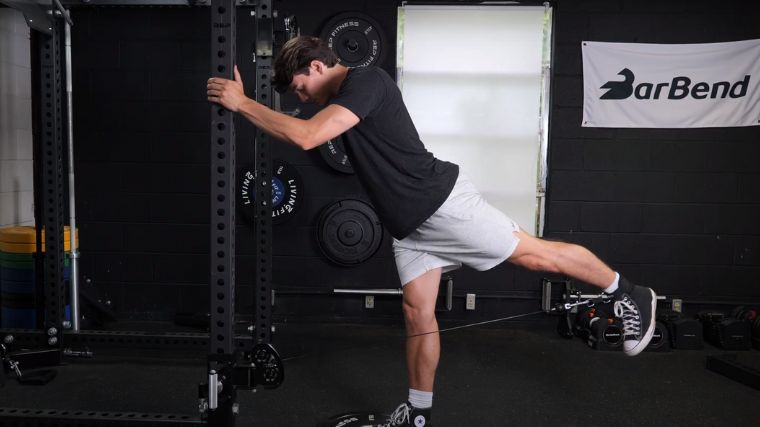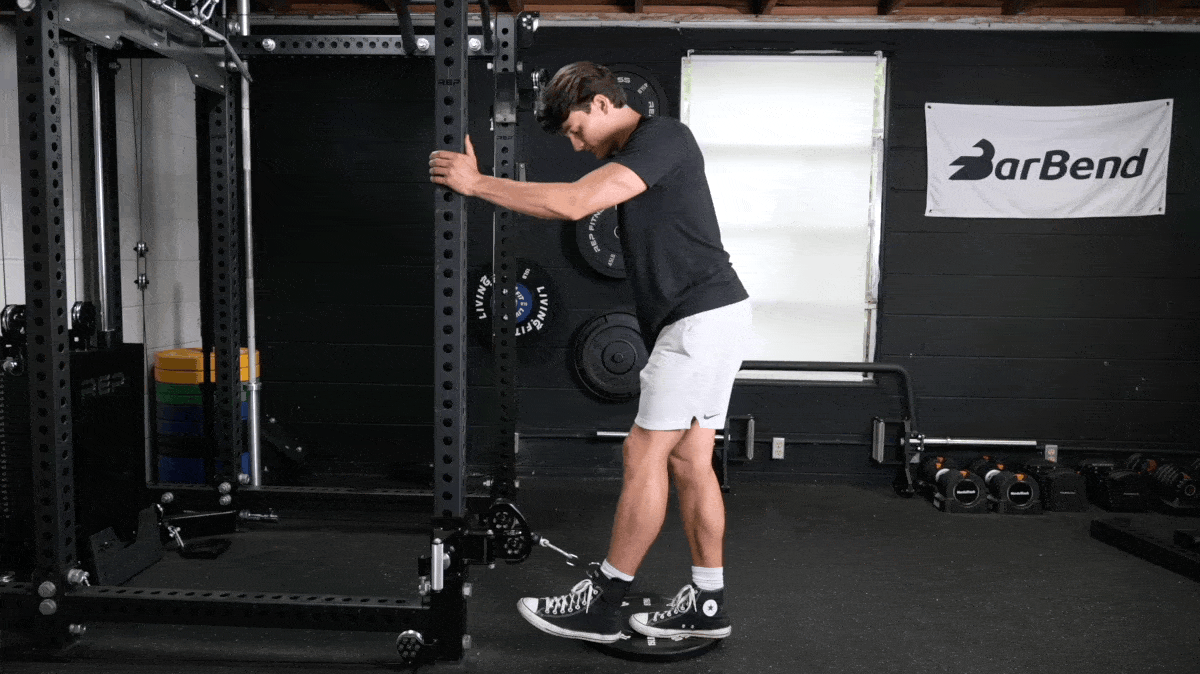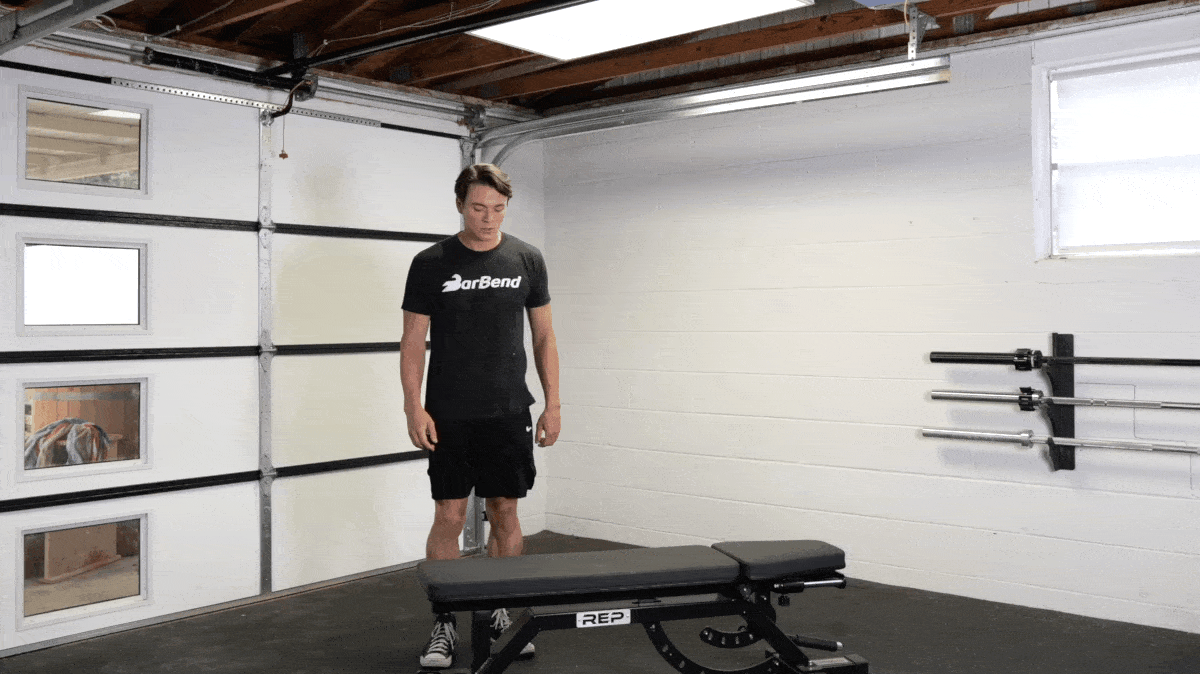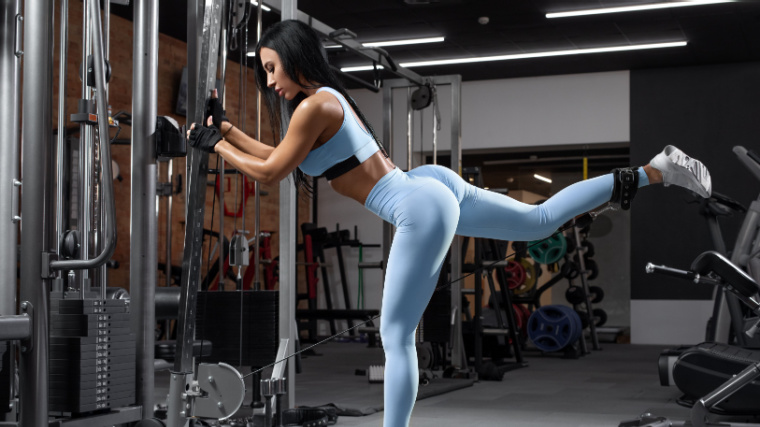If you’ve been on board the bigger butt train, certain lower body exercises stand out. Squats, deadlifts, lunges, and hip thrusts have the center stage. But when you’re likely too tired for another set of squats, the glute kickback is ready to target your backside — without the added strain of another heavy barbell.

Here’s how this glute accessory exercise can up your gains.
How to Do the Glute Kickback
The glute kickback is a cable-based exercise that allows you to specifically target your glutes. It is performed using a few different implements or specialty pieces of equipment, but the simple cable machine serves as the standard. Here’s how to perform the glute kickback.

- Step 1 — Place the ankle strap on the cable machine carabiner and adjust its height to the lowest position
- Step 2 — With the ankle strap around your ankle, face the cable machine and lightly hinge to stabilize. Place most of your weight on the non-working leg. This is your starting position.
- Step 3 — Using your hands and free leg to brace, press into the machine to create a counterforce to your kickback. Brace your core, tighten your legs, and secure your grip on the cable machine as stability points.
- Step 4 — Keep your working leg long, with only a subtle bend at the knee. Squeeze your glute on the working side as you drive your leg backward against the resistance.
- Step 5 – Once your glute has fully contracted, slowly lower back to the starting position. Perform for repetitions.
Coach’s Tip: Start your sets with your non-dominant side, which is often your weaker side. This way, you’re setting a movement standard that you can accomplish evenly.
Glute Kickback Variations
The glute kickback is a great way to isolate your glutes as much as possible and pepper in much-needed training volume without taxing your lower back under a barbell.
If you’re searching for some variations on the glute kickback, a few great choices are the donkey kick, a machine glute kickback, or a 45-degree cable kickback.
Donkey Kick
[Read More: 10 Glute Exercises You Can Do at Home]
Why Do It: This bodyweight glute exercise is a way to isolate your glutes without weight. You’ll get the added bonus of a balance challenge and solid mind-muscle connection.
Equipment Needed: You don’t need anything except yourself and possibly a yoga mat here.
- Begin in the quadruped position (on the floor on your hands and knees).
- Brace your core and tighten your back to stabilize your position.
- Squeeze your right glute, raising your right leg into the air. Lower it back down to the starting position and repeat with the left leg for repetitions.
Glute Kickback Machine
[Read More: Better Glutes, Better Pulls: How Should We Approach Glute Training For Powerlifting]
Why Do It: Here, you’ll have a machine to brace your body against. Take advantage and up the weight with this isolation exercise so that you can focus as much as possible on the activation of your gluteal muscles.
Equipment Needed:
- Line up in the machine with your working foot flat against the footpad and your hands or shoulders braced against the pads provided.
- Squeeze your hands and engage full body tension to provide stability.
- Drive your working leg backward by pressing through the full foot. Extend the leg until you feel a complete glute contraction.
- Slowly lower back to the starting position and repeat for repetitions.
45-Degree Cable Kickback
[Read More: The 15 Best Cable Exercises for Hypertrophy, Strength, and Stability]
Why Do It: These cable glute kickbacks keep your leg at 45 degrees. Keeping your leg this way will bring your hamstrings and calves more into the movement, and it also targets your gluteus medius a little more than the usual variation.
Equipment Needed: This move just needs a cable machine and ankle strap.
- Set up your cable machine the same way you would a standard glute kickback.
- Brace against the machine and stabilize your body. Drive your working leg backward at an approximate 45-degree angle.
- Fully contract the working glute to complete each repetition. Slowly lower back to the starting position and repeat for repetitions.
Glute Kickback Alternatives
If your cable machine is out of commission or you’re simply looking for some alternatives to play with, we’ve got some great alternatives for you. The best exercises here will give your glutes fantastic stimulation while allowing different angles than your major lower body exercises.
Resistance Band Abduction
[Read More: Best Resistance Bands for Glutes of 2024]
Why Do It: Many athletes do moves like this one to warm up for squats, and with good reason. Train yourself to resist unintended, overexaggerated collapsing of your knees inward during loaded squats and other knee-and-hip focused moves.
Equipment Needed: You’ll need a plyo box or a weight bench, along with a mini resistance band.
- Take a seat on the edge of a bench or a box. Wrap a resistance band around your knees.
- Slightly hinge forward and brace in this position. Engage your core and pre-tighten your legs.
- Drive your knees out against the band resistance. Keep squeezing until your glutes feel fully contracted. Return to the starting position under control and repeat for repetitions.
Machine Hip Abduction
[Read More: Are You Leaving Glute Gains On the Table? Try This Two-Move Finisher]
Why Do It: Since you’ll be seated and braced against the machine, you can afford to up the weight once you’re sufficiently warmed up. You can load heavily without strain on your lower back or overall body.
Equipment Needed: You’ll have to find a hip abduction machine for this one. Otherwise, opt for the banded version, described above.
- Sit down in the machine with your outer legs snug against the pads and your back flat against the backrest.
- Start with the machine in the position that allows your legs to begin as close together as possible.
- Brace your full body and maintain this starting posture. Drive your legs out against the pads until your glutes have fully contracted. Repeat for repetitions.
Step-Up

Why Do It: You can customize this move to your mobility and fitness level by using a different size step (or plyo box). That way, beginners can take this move to the next level while advanced athletes can also use it to improve mobility and unilateral strength while jacking up the heart rate.
Equipment Needed: Use a step-up platform or plyo box for this one. Dumbbells in your hands are optional.
- Select a box that allows you to get approximately 90 degrees or more of knee flexion.
- Place one foot on the box, brace your core, and tighten your legs.
- Place as much weight as possible on the working leg and step onto the box.
- Lower yourself under control back to the starting position. Avoid letting gravity do the work as much as possible. Repeat for even repetitions per leg.
Who Should Do the Glute Kickback
The glute kickback is often overlooked as a prominent glute exercise, though it shouldn’t be. It has clear benefits for physique enthusiasts but also is extremely helpful for gym newbies and older lifters alike.
- Physique Enthusiasts: If you want to compete in bodybuilding or simply have some jeans you want to fill out, glutes are a must. Outside of big barbell or machine exercises (such as squats or leg presses), the glute kickback has been a fixture for physique enthusiasts for ages. The precision targeting and ability to train with greater frequency cannot be beaten.
- Beginners: There are a lot of transferable benefits that a newcomer to the gym gains from the glute kickback. The central focus is always gaining muscle mass, but the set-up and execution of a good cable-based glute kickback teach a ton about proprioception and discipline. This reinforces proper technique and allows you to chase high-intensity sets through the burn instead of heavy weights.
- Older Lifters: A strong set of hips is a huge asset as you age, and the glute kickback is a lifter-friendly way to keep targeting your glutes. Many of the staple lower body exercises that hit your glutes are also very physically demanding in other ways. The glute kickback provides a low barrier to entry method of stimulating the hips, building proprioception, and confidence for an older or less experienced lifter.
Glute Kickback Sets and Reps
The glute kickback isn’t one that you’re going to do for max load. Since you are using a long lever with your leg, heavier loading would break down your form too quickly. Instead, try using sets and reps for muscle, endurance, or even warming up.,
- For Muscle Mass: Perform 2-4 sets of 10-15 repetitions. Aim for 1-2 repetitions in the tank at the end of each set and rest for 90 seconds to 2 minutes between sets.
- For Endurance: To build endurance, perform 3-4 sets of 15-20 repetitions per leg. Plan for only 30 seconds of rest between sets and aim to feel a vicious burn.
- For Warming Up: To warm up for other lower body exercises, perform 1-2 sets of 15-20 repetitions per leg. Use a 1-2 second pause in the fully contracted position for the best results.
Benefits of the Glute Kickback
The glute kickback builds your glutes, especially when you combine it with a full lower-body workout. It stands out because it also allows for some precision targeting of specific sections of your glutes and deals with significantly less load than the barbell exercises in your program.
Bigger Glutes
Most of the tools in your glute workout box are going to be compound exercises. This means that they may also target your quads and hamstrings, and certainly engage your core. The glute kickback helps to work around these other muscles, making it easier to isolate your glutes as the main target.
Precision Targeting
With more specific isolation comes a better chance at growth. Here, you’ll be more successful in making the glutes your primary muscle without other areas getting in the way and building fatigue.
The glute kickback doesn’t just make it easier to isolate your whole glute — you’re also able to angle the exercise to help load certain regions of your butt. The gluteus maximus, medius, and minimus make up the three major glute muscles and all contribute to your glute kickback.
Choosing specific angles to perform your kickback helps to align with the muscle fibers of your gluteus medius. Your gluteus maximus is the workhorse of force production, but choosing a 45-degree angle for execution helps stress your gluteus medius a bit more too.
Lighter Load
One of the biggest benefits of cable-based exercises is the lighter loads needed to gain stimulus compared to free weights. The glute kickback is no exception. Compared to a squat or a deadlift, the glute kickback needs next to no weight to make it a challenge.
Since you keep your leg long and use precise control to perform your glute kickback, even lighter loads feel heavy. You’ll still get great growth but it also allows you to use way less weight to accomplish the goal.
Muscles Worked by the Glute Kickback
The glutes are the major muscle group worked by the glute kickback. The glutes are broken down into their three distinct muscles; being, the gluteus maximus, the gluteus medius, and the gluteus minimus.
|
Gluteus Maximus |
Gluteus Medius |
Gluteus Minimus |
|
|
|
[Read More: Try These Kettlebell Glute Workouts to Kick Your Butt Into High Gear]
Common Glute Kickback Mistakes
Although the glute kickback is a relatively straightforward exercise, there are still some common mistakes that flare up from time to time. Not bracing properly, adding too much momentum, and improper load selection are the biggest culprits.
Not Bracing Properly
The point of the glute kickback is to target and stimulate the glutes as specifically as possible. This means squeezing your butt, and subsequently, your butt moving the weight. While that may sound silly, the reality is that a lot of lifters move other parts of their body to accomplish the glute kickback.
Anchoring yourself in place with a strong brace and counterforce against the machine (using your arms to lock yourself in a specific position) are key ways to isolate your glutes. Do not allow your lower back to arch, don’t flare your upper back, or sway your hips. Brace up, and only contract your glutes. Movement from your butt should move that pulley, nothing else.
Momentum
Momentum is an issue with nearly every exercise from time to time. And sometimes, a bit of body English toward the end of your set can help you push past failure and add some extra growth potential.

The issue arises when you accidentally use momentum that you didn’t mean to do, kicking in other areas of lower body strength to get you to the top of the movement without enough challenge to your glutes. Be disciplined, brace up, and only contract your glutes with proper form and a full range of motion.
Too Much Weight
The glute kickback takes advantage of a longer level system than say a leg press. This means that your leg staying relatively locked out keeps the resistance further from the muscle that is moving it. This makes the weight feel heavier and thus you need less of it to perform the glute kickback.
[Read More: Are Squats the Most Effective Exercise for the Glutes?]
This also means the glute kickback is susceptible to form breakdown if you load it too much. This same longer lever amplifies the challenge against your brace, meaning shooting for strength is likely to break you down even faster. Aim for loading schemes that allow you to mainly feel the glute, maintain position, and hit close to muscle failure around 10 to 15 repetitions.
Kicking Into High Gear
The glute kickback has been lurking around gyms since the introduction of cable machines. While some lifters hesitate to add them in, glute kickbacks pair just as well with squats and deadlifts as the dumbbell flye does with the bench press. For added glute gains with less load, a great proprioception builder, and a way to chisel in specific areas of your backside, look no further than the glute kickback.
FAQs
The glute kickback is a great way to add some spice to your lower body routine. Here are answers to any lingering questions.
Glute kickbacks are fantastic for the glutes. Think of them as the dumbbell flye to your bench press or straight-arm pulldown to your dumbbell row. They give you another huge shot of stimulation for glute growth from a different angle and use less weight to accomplish the job. They serve as a fantastic synergist to your squat or hip hinge moves.
The question of “better” depends on what you want. If you want a glute isolation exercise, then you want the kickback. Searching for a way to build stronger glutes without taxing your lower back or other parts of your lower body? The glute kickback wins that, too.
But if you want an overall strength and mass builder that heavily involves the glutes, the squat takes the cake.
For a well-balanced program, aim to integrate both of them into your workouts. The better philosophy is to integrate them both into your workouts. Generally, you’ll start your day with squats and use the kickback as an accessory move.
The glute kickback primarily works your gluteus maximus, medius, and minimus. While this move is by no means a core exercise, you’ll also need to brace through your core.
The post How to Do Glute Kickbacks to Build Your Butt appeared first on BarBend.

